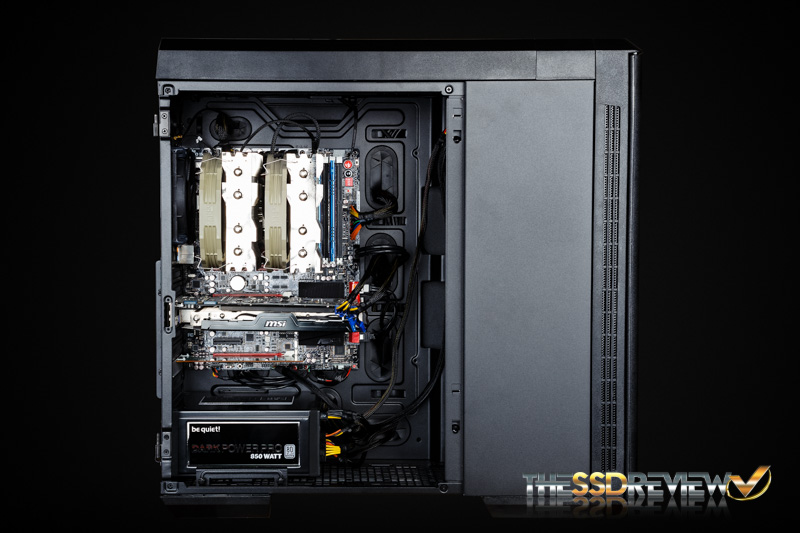TSSDR TEST BENCH AND PROTOCOL
SSD Testing at TSSDR differs slightly, depending on whether we are looking at consumer or enterprise SSDs. For consumer SSDs, our goal is to test in a system that has been optimized with our SSD Optimization Guide. To see the best performance possible the CPU C states have been disabled, C1E support has been disabled, Enhanced Intel SpeedStep Technology (EIST) has been disabled. Benchmarks for consumer testing are also benchmarks with a fresh drive so, not only can we verify that manufacturer specifications are in line but also, so the consumer can replicate our tests to confirm that they have an SSD that is top-notch. We even provide links to most of the benchmarks used in the report.
This is an updated test bench and, as such, we would love to thank those who jumped in specifically to help the cause. Key contributors to this build are our friends at ASUS for the motherboard and be quiet! for the PSU and cooling fans. Also, a big thank you to Thermaltake for the case they provided. We have detailed all components in the table below and they are all linked should you wish to make a duplicate of our system as so many seem to do, or check out the price of any single component. As always, we appreciate your support in any purchase through our links!
SYSTEM COMPONENTS
This Test Bench build was the result of some great relationships and purchase; our appreciation goes to the below mentioned manufacturers for their support in our project. All of the components we use for testing and evaluation can be easily purchased at a relatively affordable price. The links provided below can assist in pricing, as well as availability for those of you who may find interest in our equipment.
| PC CHASSIS: | Thermaltake Urban T81 |
| MOTHERBOARD: | Asus Maximus VI Extreme |
| CPU: | Intel Core i5-4670K |
| CPU COOLER: | Thermalright Silver Arrow |
| POWER SUPPLY: | be quiet! Dark Power Pro 10 850W |
| SYSTEM COOLING: | be quiet! Silent Wings 2 |
| GRAPHICS CARD: | MSI GTX 660 Ti PE OC |
| MEMORY: | G.Skill Ares DDR3-1866Mhz Memory |
BENCHMARK SOFTWARE AND METHODOLOGY
The software we will be using for today’s analysis is typical of many of our reviews, Crystal Disk Mark. In consumer reports, we prefer to test with easily accessible software that the consumer can obtain, and in many cases, we even provide links. Our selection of software allows each to build on the last and to provide validation to results already obtained.
For our testing we will be using two different SSDs. One being a 128GB Samsung 830 and the other being a 512GB Crucial MX100. This is just to show just how easily and fast you can set up this device with any drive pair. Keep in mind, the RAID arrays will be limited to the slowest speed drive and lowest capacity drive in the array.
CRYSTAL DISK BENCHMARK VER. 3.0 X64
Crystal Disk Benchmark is used to measure read and write performance through sampling of random data which is, for the most part, incompressible. Performance is virtually identical, regardless of data sample so we have included only that using random data samples.
First up are our JBOD results for each drive. As we can see from our first round, the RAIDON Runner is already performing far more than its rated specs. Reads reach just over 420MB/s and writes reach 445.6MB/s. Furthermore, we can see that 4k read speeds are not too far off from SATA speeds reaching over 25MB/s for 4K read and up to 64.47MB/s for 4K write.
Next,we have our RAID 0 results. Again, far more than the rated speeds. It was able to reach a max of 425.1MB/s read and 420.6MB/s write.
Finally, we have our RAID 1 results. The max read reaches 411.3MB/s and write reaches 321.3MB/s. The Samsung 830 is the reason for the lower than rated write speeds. In RAID 1, the speeds are limited by the slowest drive in the array.
REPORT ANALYSIS AND FINAL THOUGHTS
In all, the RAIDON Runner has proved to be a decent external enclosure. Its sleek design and performance would be a great benefit for those seeking a solid external enclosure to use in a professional media setting, photographers and video editors especially. When two drives are in the RAIDON Runner in RAID 1, data is duplicated in real time so if there is a single drive failure your workflow will not be interrupted. If you are looking to put some high capacity HDDs in the enclosure and use RAID 0, you shouldn’t be disappointed as the device easily allows for plenty of high speed bandwidth. And if you need to swap drives around multiple systems, you can quickly and easily do so when the device is set to JBOD mode.
With an enclosure like this you don’t have to give up portability over performance anymore, although it’s not meant for every PC user, those looking for something like this may now have found a clear choice.
Check out the RAIDON Runner on Amazon.com Today!
 The SSD Review The Worlds Dedicated SSD Education and Review Resource |
The SSD Review The Worlds Dedicated SSD Education and Review Resource | 


would this work with the xbox one?
Yes, it does.
Does this need 12v power in to operate? Or will USB bus power run it with two SSDs?
It needs the 12v power.